PGBM02 - Leading People: Managing Change for Organizational Impact
VerifiedAdded on 2023/04/23
|14
|4154
|438
Essay
AI Summary
This essay discusses the crucial relationship between line managers and leaders in driving organizational effectiveness, focusing on managing and leading change as a key practice. It examines the roles of both line managers and leaders in implementing and navigating organizational change, referencing John Kotter's change management theory. The essay highlights the importance of adapting to customer preferences and market competition, and how effective change management can improve productivity, employee performance, and financial stability. The document also emphasizes the significance of conflict management and the integration of modern technology for business expansion. Desklib provides access to this document and a wealth of study resources.

Running head: MANAGING AND LEADING PEOPLE
Managing and Leading People
Name of the Student
Name of the University
Author Note
Managing and Leading People
Name of the Student
Name of the University
Author Note
Paraphrase This Document
Need a fresh take? Get an instant paraphrase of this document with our AI Paraphraser
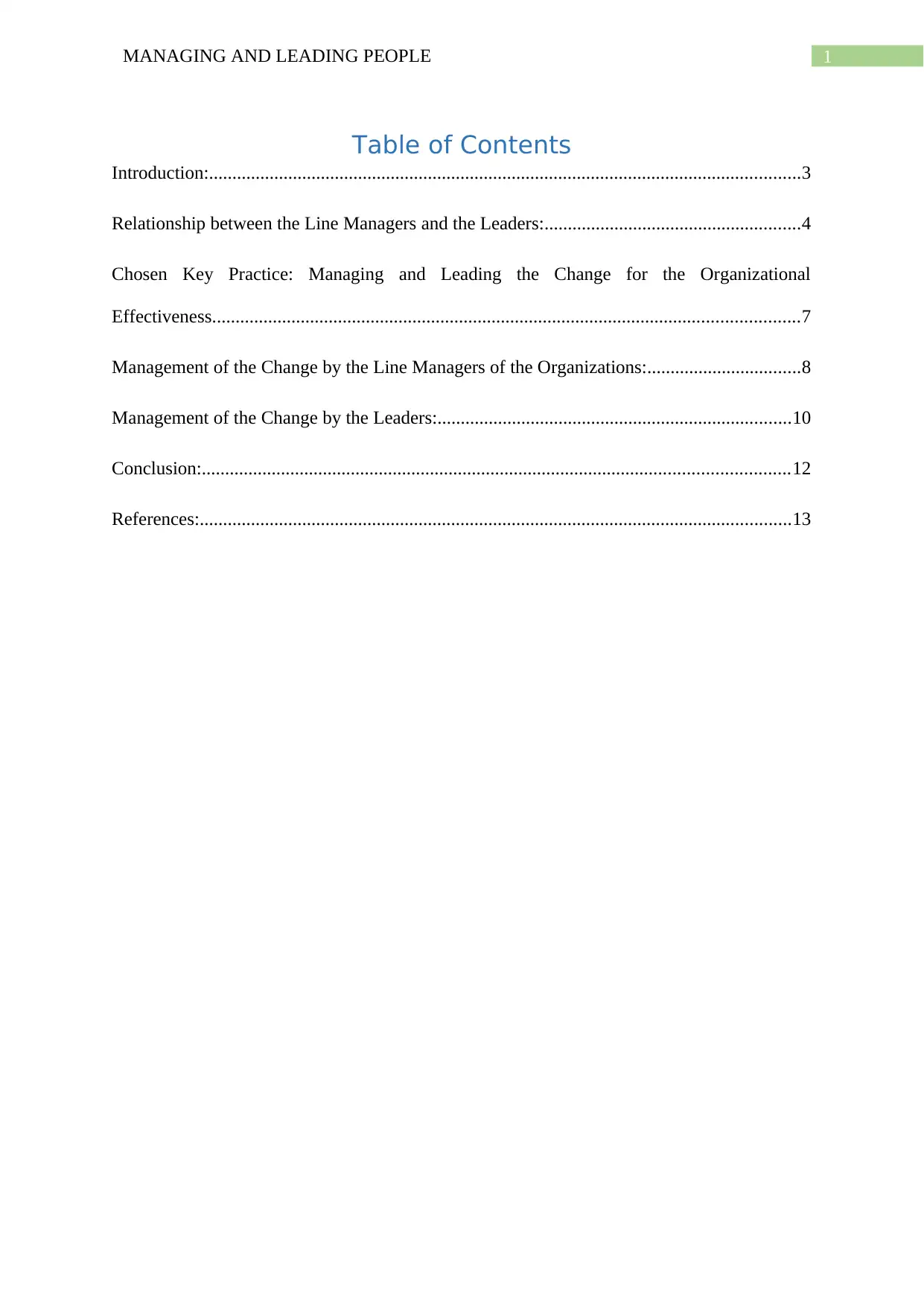
1MANAGING AND LEADING PEOPLE
Table of Contents
Introduction:...............................................................................................................................3
Relationship between the Line Managers and the Leaders:.......................................................4
Chosen Key Practice: Managing and Leading the Change for the Organizational
Effectiveness..............................................................................................................................7
Management of the Change by the Line Managers of the Organizations:.................................8
Management of the Change by the Leaders:............................................................................10
Conclusion:..............................................................................................................................12
References:...............................................................................................................................13
Table of Contents
Introduction:...............................................................................................................................3
Relationship between the Line Managers and the Leaders:.......................................................4
Chosen Key Practice: Managing and Leading the Change for the Organizational
Effectiveness..............................................................................................................................7
Management of the Change by the Line Managers of the Organizations:.................................8
Management of the Change by the Leaders:............................................................................10
Conclusion:..............................................................................................................................12
References:...............................................................................................................................13
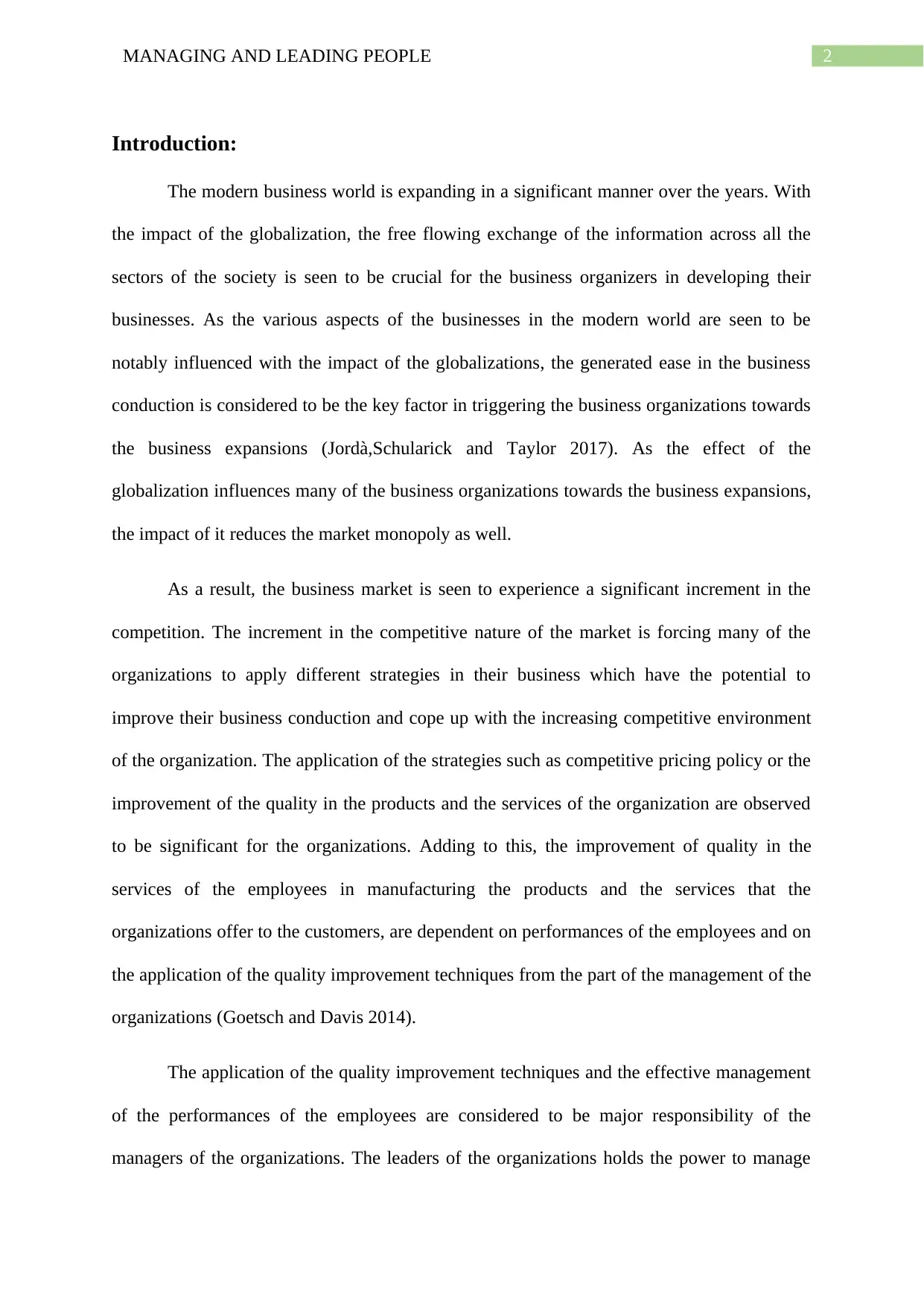
2MANAGING AND LEADING PEOPLE
Introduction:
The modern business world is expanding in a significant manner over the years. With
the impact of the globalization, the free flowing exchange of the information across all the
sectors of the society is seen to be crucial for the business organizers in developing their
businesses. As the various aspects of the businesses in the modern world are seen to be
notably influenced with the impact of the globalizations, the generated ease in the business
conduction is considered to be the key factor in triggering the business organizations towards
the business expansions (Jordà,Schularick and Taylor 2017). As the effect of the
globalization influences many of the business organizations towards the business expansions,
the impact of it reduces the market monopoly as well.
As a result, the business market is seen to experience a significant increment in the
competition. The increment in the competitive nature of the market is forcing many of the
organizations to apply different strategies in their business which have the potential to
improve their business conduction and cope up with the increasing competitive environment
of the organization. The application of the strategies such as competitive pricing policy or the
improvement of the quality in the products and the services of the organization are observed
to be significant for the organizations. Adding to this, the improvement of quality in the
services of the employees in manufacturing the products and the services that the
organizations offer to the customers, are dependent on performances of the employees and on
the application of the quality improvement techniques from the part of the management of the
organizations (Goetsch and Davis 2014).
The application of the quality improvement techniques and the effective management
of the performances of the employees are considered to be major responsibility of the
managers of the organizations. The leaders of the organizations holds the power to manage
Introduction:
The modern business world is expanding in a significant manner over the years. With
the impact of the globalization, the free flowing exchange of the information across all the
sectors of the society is seen to be crucial for the business organizers in developing their
businesses. As the various aspects of the businesses in the modern world are seen to be
notably influenced with the impact of the globalizations, the generated ease in the business
conduction is considered to be the key factor in triggering the business organizations towards
the business expansions (Jordà,Schularick and Taylor 2017). As the effect of the
globalization influences many of the business organizations towards the business expansions,
the impact of it reduces the market monopoly as well.
As a result, the business market is seen to experience a significant increment in the
competition. The increment in the competitive nature of the market is forcing many of the
organizations to apply different strategies in their business which have the potential to
improve their business conduction and cope up with the increasing competitive environment
of the organization. The application of the strategies such as competitive pricing policy or the
improvement of the quality in the products and the services of the organization are observed
to be significant for the organizations. Adding to this, the improvement of quality in the
services of the employees in manufacturing the products and the services that the
organizations offer to the customers, are dependent on performances of the employees and on
the application of the quality improvement techniques from the part of the management of the
organizations (Goetsch and Davis 2014).
The application of the quality improvement techniques and the effective management
of the performances of the employees are considered to be major responsibility of the
managers of the organizations. The leaders of the organizations holds the power to manage
⊘ This is a preview!⊘
Do you want full access?
Subscribe today to unlock all pages.

Trusted by 1+ million students worldwide

3MANAGING AND LEADING PEOPLE
the performances of the employees with the formation of the suitable strategies that have the
potential to improve the business conduction of the organizations. The paper is focused in the
elaboration of the topic of managing and leading the change for the organizational
effectiveness. The paper evaluates the relations between the role of leaders and the managers.
Apart from this, the paper offers an explanation regarding the key practices in managing the
change with an objective of improving the organizational effectiveness. Adding to this, the
paper discusses the activities or the operations that the managers or leaders conduct in order
to manage the organizational change with precise inclusion of the different models and the
techniques.
Relationship between the Line Managers and the Leaders:
The operation of the line mangers is to directly manage the employees of the
organization to effectively align their activities with the objectives of the organizations.
Along with the precise monitoring of the performances of the employees, the line managers
are responsible to report the higher authority regarding the progress of the organizational
performances (Bos‐Nehles, Van Riemsdijk and Kees Looise 2013). Adding to this, the
operations of the line managers are observed to include the effective management of the
resources for the achievement of the larger output. The general operations of the line
managers include efficient recruitment and the hiring of the talents, identifying the
developmental needs of the new recruitments and providing the much required training for
the new recruitments, effective allocation of the tasks with a precise focus on the expertise of
the employees of the organization, production of the feedbacks to the employees of the
organization to make sure that the employees be aware of the technique and the procedures to
identify their shortcomings and meet them with the appropriate formation of the strategies.
Adding to this, the line managers are also responsible for the effective communication of the
objectives of different departments to the employees along with the efficient evaluation of the
the performances of the employees with the formation of the suitable strategies that have the
potential to improve the business conduction of the organizations. The paper is focused in the
elaboration of the topic of managing and leading the change for the organizational
effectiveness. The paper evaluates the relations between the role of leaders and the managers.
Apart from this, the paper offers an explanation regarding the key practices in managing the
change with an objective of improving the organizational effectiveness. Adding to this, the
paper discusses the activities or the operations that the managers or leaders conduct in order
to manage the organizational change with precise inclusion of the different models and the
techniques.
Relationship between the Line Managers and the Leaders:
The operation of the line mangers is to directly manage the employees of the
organization to effectively align their activities with the objectives of the organizations.
Along with the precise monitoring of the performances of the employees, the line managers
are responsible to report the higher authority regarding the progress of the organizational
performances (Bos‐Nehles, Van Riemsdijk and Kees Looise 2013). Adding to this, the
operations of the line managers are observed to include the effective management of the
resources for the achievement of the larger output. The general operations of the line
managers include efficient recruitment and the hiring of the talents, identifying the
developmental needs of the new recruitments and providing the much required training for
the new recruitments, effective allocation of the tasks with a precise focus on the expertise of
the employees of the organization, production of the feedbacks to the employees of the
organization to make sure that the employees be aware of the technique and the procedures to
identify their shortcomings and meet them with the appropriate formation of the strategies.
Adding to this, the line managers are also responsible for the effective communication of the
objectives of different departments to the employees along with the efficient evaluation of the
Paraphrase This Document
Need a fresh take? Get an instant paraphrase of this document with our AI Paraphraser
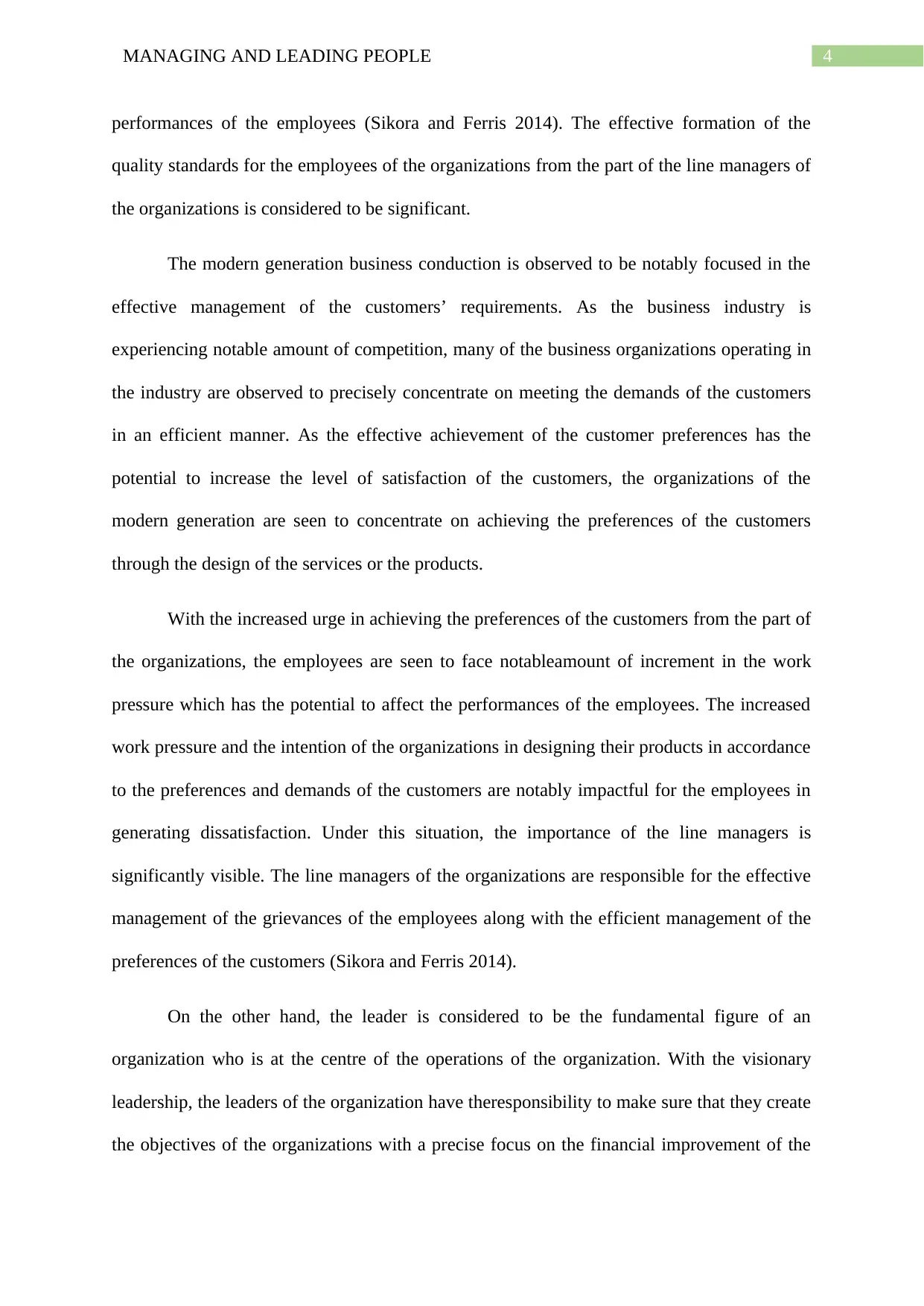
4MANAGING AND LEADING PEOPLE
performances of the employees (Sikora and Ferris 2014). The effective formation of the
quality standards for the employees of the organizations from the part of the line managers of
the organizations is considered to be significant.
The modern generation business conduction is observed to be notably focused in the
effective management of the customers’ requirements. As the business industry is
experiencing notable amount of competition, many of the business organizations operating in
the industry are observed to precisely concentrate on meeting the demands of the customers
in an efficient manner. As the effective achievement of the customer preferences has the
potential to increase the level of satisfaction of the customers, the organizations of the
modern generation are seen to concentrate on achieving the preferences of the customers
through the design of the services or the products.
With the increased urge in achieving the preferences of the customers from the part of
the organizations, the employees are seen to face notableamount of increment in the work
pressure which has the potential to affect the performances of the employees. The increased
work pressure and the intention of the organizations in designing their products in accordance
to the preferences and demands of the customers are notably impactful for the employees in
generating dissatisfaction. Under this situation, the importance of the line managers is
significantly visible. The line managers of the organizations are responsible for the effective
management of the grievances of the employees along with the efficient management of the
preferences of the customers (Sikora and Ferris 2014).
On the other hand, the leader is considered to be the fundamental figure of an
organization who is at the centre of the operations of the organization. With the visionary
leadership, the leaders of the organization have theresponsibility to make sure that they create
the objectives of the organizations with a precise focus on the financial improvement of the
performances of the employees (Sikora and Ferris 2014). The effective formation of the
quality standards for the employees of the organizations from the part of the line managers of
the organizations is considered to be significant.
The modern generation business conduction is observed to be notably focused in the
effective management of the customers’ requirements. As the business industry is
experiencing notable amount of competition, many of the business organizations operating in
the industry are observed to precisely concentrate on meeting the demands of the customers
in an efficient manner. As the effective achievement of the customer preferences has the
potential to increase the level of satisfaction of the customers, the organizations of the
modern generation are seen to concentrate on achieving the preferences of the customers
through the design of the services or the products.
With the increased urge in achieving the preferences of the customers from the part of
the organizations, the employees are seen to face notableamount of increment in the work
pressure which has the potential to affect the performances of the employees. The increased
work pressure and the intention of the organizations in designing their products in accordance
to the preferences and demands of the customers are notably impactful for the employees in
generating dissatisfaction. Under this situation, the importance of the line managers is
significantly visible. The line managers of the organizations are responsible for the effective
management of the grievances of the employees along with the efficient management of the
preferences of the customers (Sikora and Ferris 2014).
On the other hand, the leader is considered to be the fundamental figure of an
organization who is at the centre of the operations of the organization. With the visionary
leadership, the leaders of the organization have theresponsibility to make sure that they create
the objectives of the organizations with a precise focus on the financial improvement of the

5MANAGING AND LEADING PEOPLE
organization (Duet al. 2013). The leaders are liable to strategize the operational activities of
the employees of the organization in organizational context. On the other hand, an efficient
leader is responsible for taking the responsibility of his or her business conduction along with
the operations of the employees working under him or her. Such an attitude from the part of
the leader has the potential to motivate the employees in an efficient manner which in case of
the line managers, is seen to exist partially (Van Wart 2013). Adding to this, an efficient
leaders is expected to be innovative and creative in providing his or her solution to the
employees which makes sure that the leader is flexible in terms of leading his or her team
(Carteret al. 2013). The required flexibility in the leadership proves to be significant for the
employees of the organization as it effectively solves the variations that are present in the
operations of the employees of the organizations.
The assessment of the performances of the employees is considered to be a major
responsibility for a leader as he or she requires to evaluate the impact of their leadership on
the performances of the employees. With the effective assessment of the impact of the
leadership on the employees of the organization, the leaders have the idea of their influence
on the employees and at the same time, is capable of identifying the employees that are able
to perform in an efficient manner. This helps in creating a productive environment inside the
organization by recognising the efficient employees of the organization (Duet al. 2013).
Apart from this, the leaders of the organization have the responsibility to come with effective
decisions which will be fruitful for the employees and for the organization. Adding to this,
the relationship between the role of the line manager and the leader will be notably
interlinked with both having the same responsibility in creating challenging goals for the
employees of the organizations to accomplish.
organization (Duet al. 2013). The leaders are liable to strategize the operational activities of
the employees of the organization in organizational context. On the other hand, an efficient
leader is responsible for taking the responsibility of his or her business conduction along with
the operations of the employees working under him or her. Such an attitude from the part of
the leader has the potential to motivate the employees in an efficient manner which in case of
the line managers, is seen to exist partially (Van Wart 2013). Adding to this, an efficient
leaders is expected to be innovative and creative in providing his or her solution to the
employees which makes sure that the leader is flexible in terms of leading his or her team
(Carteret al. 2013). The required flexibility in the leadership proves to be significant for the
employees of the organization as it effectively solves the variations that are present in the
operations of the employees of the organizations.
The assessment of the performances of the employees is considered to be a major
responsibility for a leader as he or she requires to evaluate the impact of their leadership on
the performances of the employees. With the effective assessment of the impact of the
leadership on the employees of the organization, the leaders have the idea of their influence
on the employees and at the same time, is capable of identifying the employees that are able
to perform in an efficient manner. This helps in creating a productive environment inside the
organization by recognising the efficient employees of the organization (Duet al. 2013).
Apart from this, the leaders of the organization have the responsibility to come with effective
decisions which will be fruitful for the employees and for the organization. Adding to this,
the relationship between the role of the line manager and the leader will be notably
interlinked with both having the same responsibility in creating challenging goals for the
employees of the organizations to accomplish.
⊘ This is a preview!⊘
Do you want full access?
Subscribe today to unlock all pages.

Trusted by 1+ million students worldwide
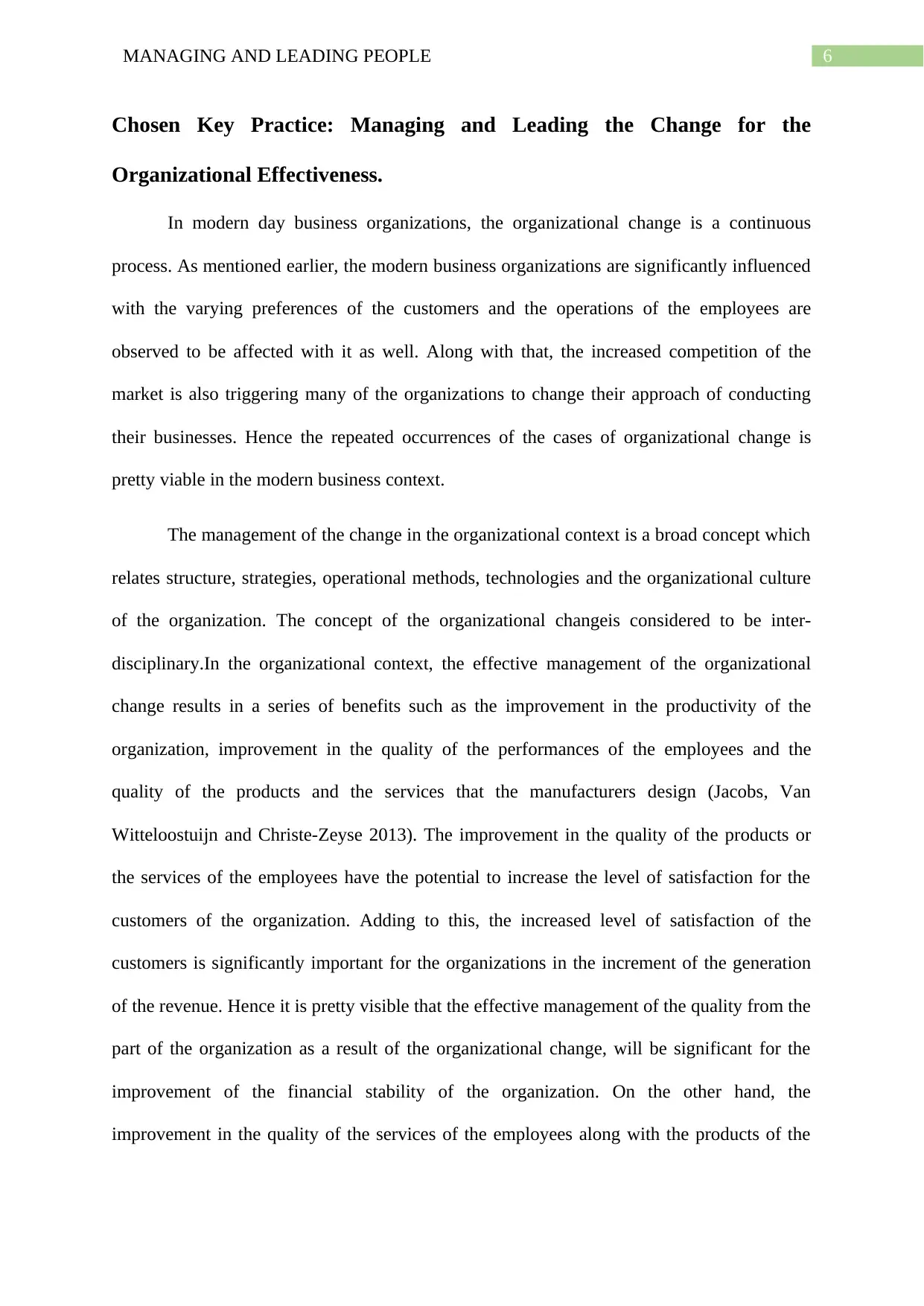
6MANAGING AND LEADING PEOPLE
Chosen Key Practice: Managing and Leading the Change for the
Organizational Effectiveness.
In modern day business organizations, the organizational change is a continuous
process. As mentioned earlier, the modern business organizations are significantly influenced
with the varying preferences of the customers and the operations of the employees are
observed to be affected with it as well. Along with that, the increased competition of the
market is also triggering many of the organizations to change their approach of conducting
their businesses. Hence the repeated occurrences of the cases of organizational change is
pretty viable in the modern business context.
The management of the change in the organizational context is a broad concept which
relates structure, strategies, operational methods, technologies and the organizational culture
of the organization. The concept of the organizational changeis considered to be inter-
disciplinary.In the organizational context, the effective management of the organizational
change results in a series of benefits such as the improvement in the productivity of the
organization, improvement in the quality of the performances of the employees and the
quality of the products and the services that the manufacturers design (Jacobs, Van
Witteloostuijn and Christe-Zeyse 2013). The improvement in the quality of the products or
the services of the employees have the potential to increase the level of satisfaction for the
customers of the organization. Adding to this, the increased level of satisfaction of the
customers is significantly important for the organizations in the increment of the generation
of the revenue. Hence it is pretty visible that the effective management of the quality from the
part of the organization as a result of the organizational change, will be significant for the
improvement of the financial stability of the organization. On the other hand, the
improvement in the quality of the services of the employees along with the products of the
Chosen Key Practice: Managing and Leading the Change for the
Organizational Effectiveness.
In modern day business organizations, the organizational change is a continuous
process. As mentioned earlier, the modern business organizations are significantly influenced
with the varying preferences of the customers and the operations of the employees are
observed to be affected with it as well. Along with that, the increased competition of the
market is also triggering many of the organizations to change their approach of conducting
their businesses. Hence the repeated occurrences of the cases of organizational change is
pretty viable in the modern business context.
The management of the change in the organizational context is a broad concept which
relates structure, strategies, operational methods, technologies and the organizational culture
of the organization. The concept of the organizational changeis considered to be inter-
disciplinary.In the organizational context, the effective management of the organizational
change results in a series of benefits such as the improvement in the productivity of the
organization, improvement in the quality of the performances of the employees and the
quality of the products and the services that the manufacturers design (Jacobs, Van
Witteloostuijn and Christe-Zeyse 2013). The improvement in the quality of the products or
the services of the employees have the potential to increase the level of satisfaction for the
customers of the organization. Adding to this, the increased level of satisfaction of the
customers is significantly important for the organizations in the increment of the generation
of the revenue. Hence it is pretty visible that the effective management of the quality from the
part of the organization as a result of the organizational change, will be significant for the
improvement of the financial stability of the organization. On the other hand, the
improvement in the quality of the services of the employees along with the products of the
Paraphrase This Document
Need a fresh take? Get an instant paraphrase of this document with our AI Paraphraser

7MANAGING AND LEADING PEOPLE
organizations will incorporate higher level of organizational excellence into the operations of
the organizations (Jones 2013).
The effective implementation of the organizational change with a precise focus onthe
management of the conflict amongst the employees of the organization will be significant for
the company in making sure that the efficiency of the organization gets improved. Apart from
this, the effective management of the conflicts amongst the employees of the organizations
has the potential to make sure that the employees of the organization conducts lesser amount
of faults and that improves the operational cost for the organization.
In addition to these benefits of the organizational change, the modern organizations
are seen to be more inclined towards the effective implementation of the change for the
competent incorporation of the modern technology and the innovative solutions into the
operations of the organizations. Adding to this, many of the business organizations are
observed to consider the idea of the change management for expanding their business in an
effective manner (Boutros and Purdie 2014). Hence it is pretty evident that the concept of
change management plays a crucial role in the improvement of the organizational
effectiveness.
Management of the Change by the Line Managers of the Organizations:
In the organizational context, the effective management of the change initiatives are
conducted by a series of individuals holding the managerial positions. The effective
management of the change from the part of the managers of the organizations is observed to
be conducted by following various theoretical frameworks.
Many of the modern organizations or more precisely the managers of the
organizations are observed to concentrate on the John Kotter’s theory of Change
Management for the effective implementation of the change initiatives inside their
organizations will incorporate higher level of organizational excellence into the operations of
the organizations (Jones 2013).
The effective implementation of the organizational change with a precise focus onthe
management of the conflict amongst the employees of the organization will be significant for
the company in making sure that the efficiency of the organization gets improved. Apart from
this, the effective management of the conflicts amongst the employees of the organizations
has the potential to make sure that the employees of the organization conducts lesser amount
of faults and that improves the operational cost for the organization.
In addition to these benefits of the organizational change, the modern organizations
are seen to be more inclined towards the effective implementation of the change for the
competent incorporation of the modern technology and the innovative solutions into the
operations of the organizations. Adding to this, many of the business organizations are
observed to consider the idea of the change management for expanding their business in an
effective manner (Boutros and Purdie 2014). Hence it is pretty evident that the concept of
change management plays a crucial role in the improvement of the organizational
effectiveness.
Management of the Change by the Line Managers of the Organizations:
In the organizational context, the effective management of the change initiatives are
conducted by a series of individuals holding the managerial positions. The effective
management of the change from the part of the managers of the organizations is observed to
be conducted by following various theoretical frameworks.
Many of the modern organizations or more precisely the managers of the
organizations are observed to concentrate on the John Kotter’s theory of Change
Management for the effective implementation of the change initiatives inside their
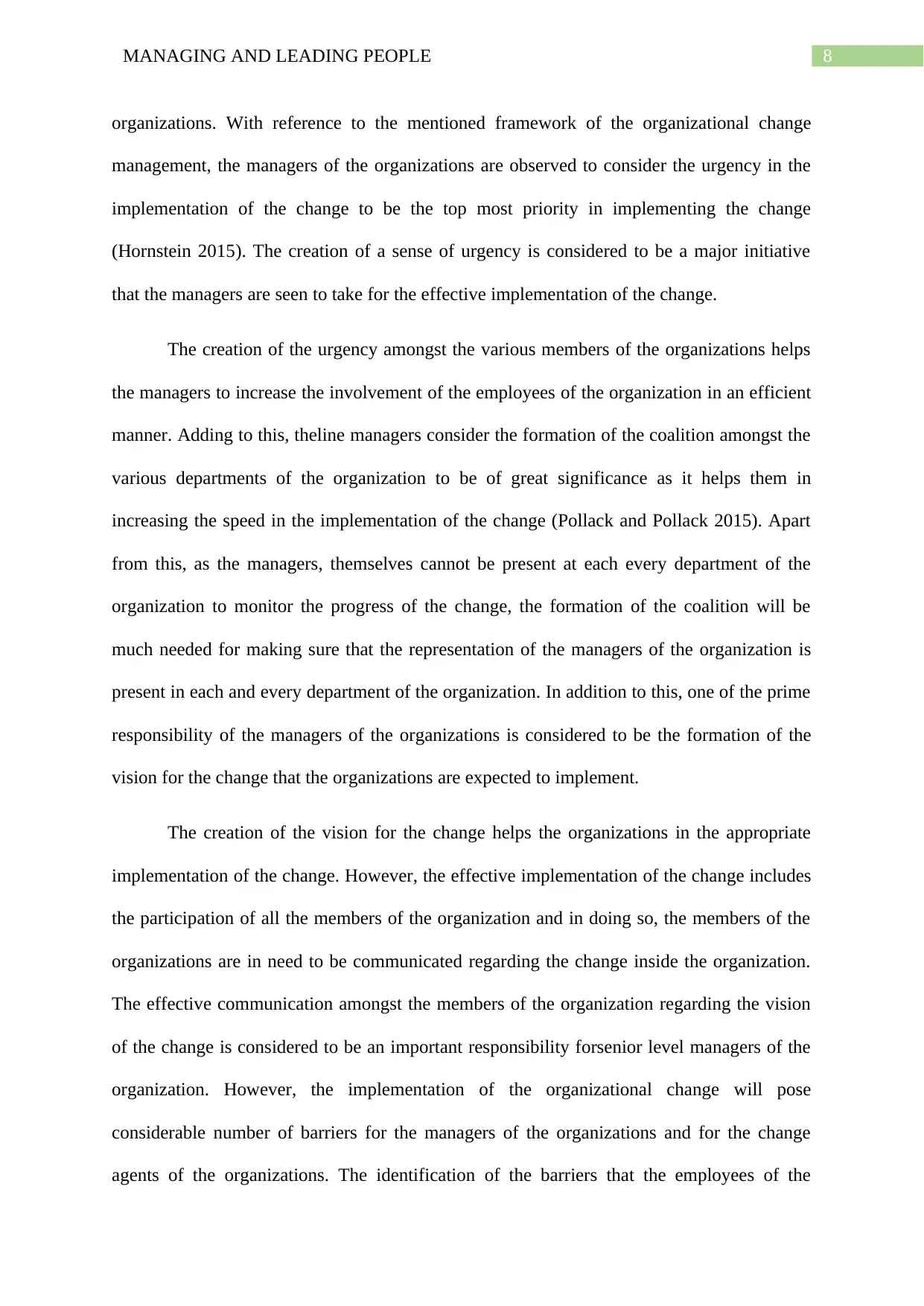
8MANAGING AND LEADING PEOPLE
organizations. With reference to the mentioned framework of the organizational change
management, the managers of the organizations are observed to consider the urgency in the
implementation of the change to be the top most priority in implementing the change
(Hornstein 2015). The creation of a sense of urgency is considered to be a major initiative
that the managers are seen to take for the effective implementation of the change.
The creation of the urgency amongst the various members of the organizations helps
the managers to increase the involvement of the employees of the organization in an efficient
manner. Adding to this, theline managers consider the formation of the coalition amongst the
various departments of the organization to be of great significance as it helps them in
increasing the speed in the implementation of the change (Pollack and Pollack 2015). Apart
from this, as the managers, themselves cannot be present at each every department of the
organization to monitor the progress of the change, the formation of the coalition will be
much needed for making sure that the representation of the managers of the organization is
present in each and every department of the organization. In addition to this, one of the prime
responsibility of the managers of the organizations is considered to be the formation of the
vision for the change that the organizations are expected to implement.
The creation of the vision for the change helps the organizations in the appropriate
implementation of the change. However, the effective implementation of the change includes
the participation of all the members of the organization and in doing so, the members of the
organizations are in need to be communicated regarding the change inside the organization.
The effective communication amongst the members of the organization regarding the vision
of the change is considered to be an important responsibility forsenior level managers of the
organization. However, the implementation of the organizational change will pose
considerable number of barriers for the managers of the organizations and for the change
agents of the organizations. The identification of the barriers that the employees of the
organizations. With reference to the mentioned framework of the organizational change
management, the managers of the organizations are observed to consider the urgency in the
implementation of the change to be the top most priority in implementing the change
(Hornstein 2015). The creation of a sense of urgency is considered to be a major initiative
that the managers are seen to take for the effective implementation of the change.
The creation of the urgency amongst the various members of the organizations helps
the managers to increase the involvement of the employees of the organization in an efficient
manner. Adding to this, theline managers consider the formation of the coalition amongst the
various departments of the organization to be of great significance as it helps them in
increasing the speed in the implementation of the change (Pollack and Pollack 2015). Apart
from this, as the managers, themselves cannot be present at each every department of the
organization to monitor the progress of the change, the formation of the coalition will be
much needed for making sure that the representation of the managers of the organization is
present in each and every department of the organization. In addition to this, one of the prime
responsibility of the managers of the organizations is considered to be the formation of the
vision for the change that the organizations are expected to implement.
The creation of the vision for the change helps the organizations in the appropriate
implementation of the change. However, the effective implementation of the change includes
the participation of all the members of the organization and in doing so, the members of the
organizations are in need to be communicated regarding the change inside the organization.
The effective communication amongst the members of the organization regarding the vision
of the change is considered to be an important responsibility forsenior level managers of the
organization. However, the implementation of the organizational change will pose
considerable number of barriers for the managers of the organizations and for the change
agents of the organizations. The identification of the barriers that the employees of the
⊘ This is a preview!⊘
Do you want full access?
Subscribe today to unlock all pages.

Trusted by 1+ million students worldwide

9MANAGING AND LEADING PEOPLE
organizations are facing along with the production of the appropriate solution to the
employees of the organization are major responsibility for the line managers of the
organizations (Worley and Mohrman 2014.).
Along with the removal of the barriers, the managers of the organizations are
responsible for the creation of the short term goals. As it is pretty evident that the
implementation of a large change inside the organization includes completion of a range of
tasks that are conducted by the employees of the organizations, the managers of the
organizations are responsible for the creation of the short terms gaols for the employees of
the organizations (Pollack and Pollack 2015). The effective completion of the short term
goals by the employees of the organizations are observed to be significant for the managers
of the organizations in case of implementing the overall change inside the organizations. The
precise focus from the part of the managers of the organizations in anchoring the change with
strong emphasis on organizational culture, the values and the mission of the organization is a
significant characteristic of the managers of the organizations.
Management of the Change by the Leaders:
However the responsibility of the leaders is observed to be bit different from the roles
and the responsibility of the leaders. Whereas the line managers are responsible for only the
implementation of such a change in which the vision of the change is designed by some other
person belonging to the higher authority, the leaders have the power to create the vision for
the changes that are to be implemented under them (Alfes, et al. 2013). The line managers of
the organizations are considered to be responsible for the allocation of the tasks for the
employees in order to accomplish the change initiative and for the effective monitoring of the
progress of the activities that the employees are allocated to complete. On the other hand, the
organizations are facing along with the production of the appropriate solution to the
employees of the organization are major responsibility for the line managers of the
organizations (Worley and Mohrman 2014.).
Along with the removal of the barriers, the managers of the organizations are
responsible for the creation of the short term goals. As it is pretty evident that the
implementation of a large change inside the organization includes completion of a range of
tasks that are conducted by the employees of the organizations, the managers of the
organizations are responsible for the creation of the short terms gaols for the employees of
the organizations (Pollack and Pollack 2015). The effective completion of the short term
goals by the employees of the organizations are observed to be significant for the managers
of the organizations in case of implementing the overall change inside the organizations. The
precise focus from the part of the managers of the organizations in anchoring the change with
strong emphasis on organizational culture, the values and the mission of the organization is a
significant characteristic of the managers of the organizations.
Management of the Change by the Leaders:
However the responsibility of the leaders is observed to be bit different from the roles
and the responsibility of the leaders. Whereas the line managers are responsible for only the
implementation of such a change in which the vision of the change is designed by some other
person belonging to the higher authority, the leaders have the power to create the vision for
the changes that are to be implemented under them (Alfes, et al. 2013). The line managers of
the organizations are considered to be responsible for the allocation of the tasks for the
employees in order to accomplish the change initiative and for the effective monitoring of the
progress of the activities that the employees are allocated to complete. On the other hand, the
Paraphrase This Document
Need a fresh take? Get an instant paraphrase of this document with our AI Paraphraser
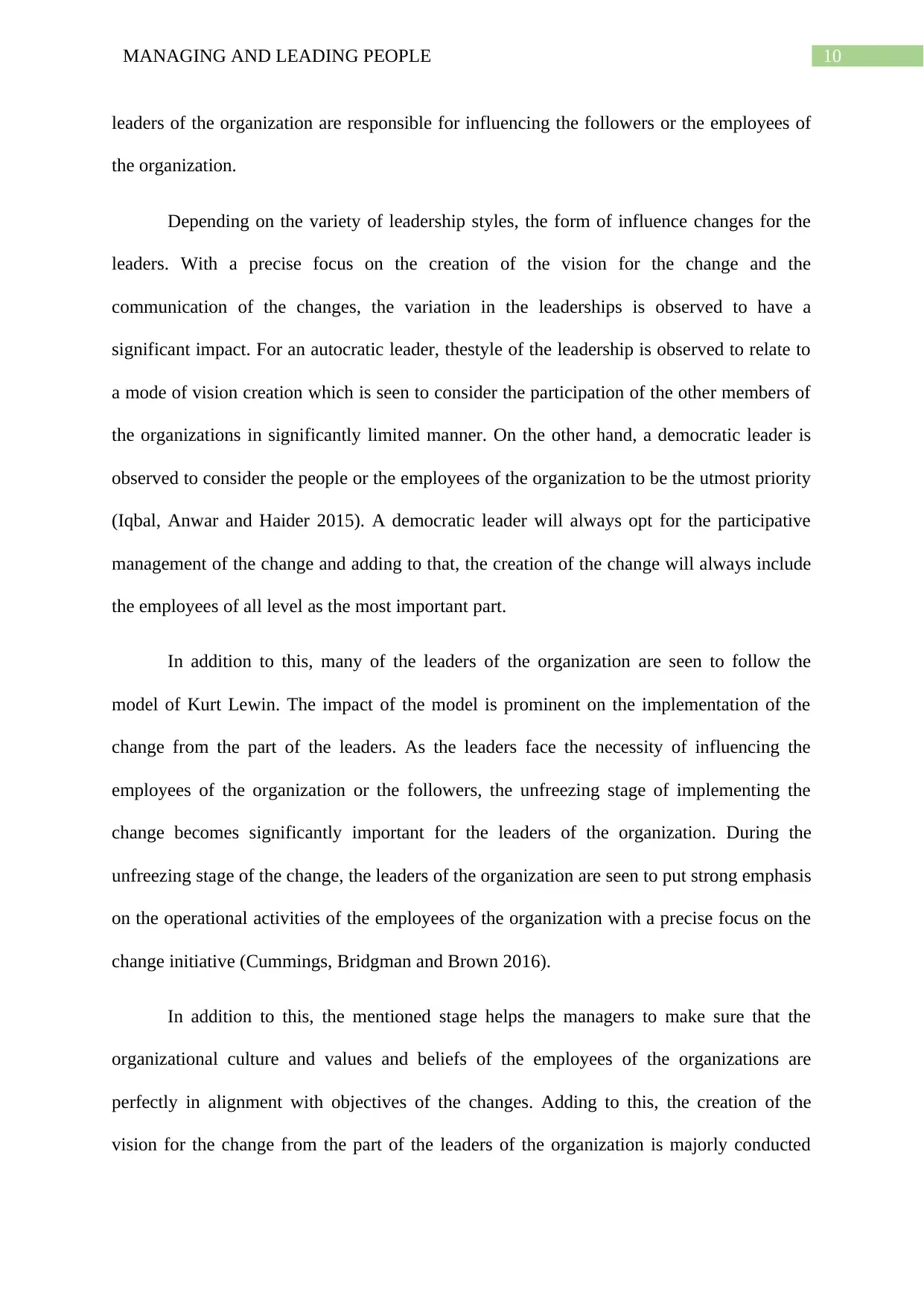
10MANAGING AND LEADING PEOPLE
leaders of the organization are responsible for influencing the followers or the employees of
the organization.
Depending on the variety of leadership styles, the form of influence changes for the
leaders. With a precise focus on the creation of the vision for the change and the
communication of the changes, the variation in the leaderships is observed to have a
significant impact. For an autocratic leader, thestyle of the leadership is observed to relate to
a mode of vision creation which is seen to consider the participation of the other members of
the organizations in significantly limited manner. On the other hand, a democratic leader is
observed to consider the people or the employees of the organization to be the utmost priority
(Iqbal, Anwar and Haider 2015). A democratic leader will always opt for the participative
management of the change and adding to that, the creation of the change will always include
the employees of all level as the most important part.
In addition to this, many of the leaders of the organization are seen to follow the
model of Kurt Lewin. The impact of the model is prominent on the implementation of the
change from the part of the leaders. As the leaders face the necessity of influencing the
employees of the organization or the followers, the unfreezing stage of implementing the
change becomes significantly important for the leaders of the organization. During the
unfreezing stage of the change, the leaders of the organization are seen to put strong emphasis
on the operational activities of the employees of the organization with a precise focus on the
change initiative (Cummings, Bridgman and Brown 2016).
In addition to this, the mentioned stage helps the managers to make sure that the
organizational culture and values and beliefs of the employees of the organizations are
perfectly in alignment with objectives of the changes. Adding to this, the creation of the
vision for the change from the part of the leaders of the organization is majorly conducted
leaders of the organization are responsible for influencing the followers or the employees of
the organization.
Depending on the variety of leadership styles, the form of influence changes for the
leaders. With a precise focus on the creation of the vision for the change and the
communication of the changes, the variation in the leaderships is observed to have a
significant impact. For an autocratic leader, thestyle of the leadership is observed to relate to
a mode of vision creation which is seen to consider the participation of the other members of
the organizations in significantly limited manner. On the other hand, a democratic leader is
observed to consider the people or the employees of the organization to be the utmost priority
(Iqbal, Anwar and Haider 2015). A democratic leader will always opt for the participative
management of the change and adding to that, the creation of the change will always include
the employees of all level as the most important part.
In addition to this, many of the leaders of the organization are seen to follow the
model of Kurt Lewin. The impact of the model is prominent on the implementation of the
change from the part of the leaders. As the leaders face the necessity of influencing the
employees of the organization or the followers, the unfreezing stage of implementing the
change becomes significantly important for the leaders of the organization. During the
unfreezing stage of the change, the leaders of the organization are seen to put strong emphasis
on the operational activities of the employees of the organization with a precise focus on the
change initiative (Cummings, Bridgman and Brown 2016).
In addition to this, the mentioned stage helps the managers to make sure that the
organizational culture and values and beliefs of the employees of the organizations are
perfectly in alignment with objectives of the changes. Adding to this, the creation of the
vision for the change from the part of the leaders of the organization is majorly conducted
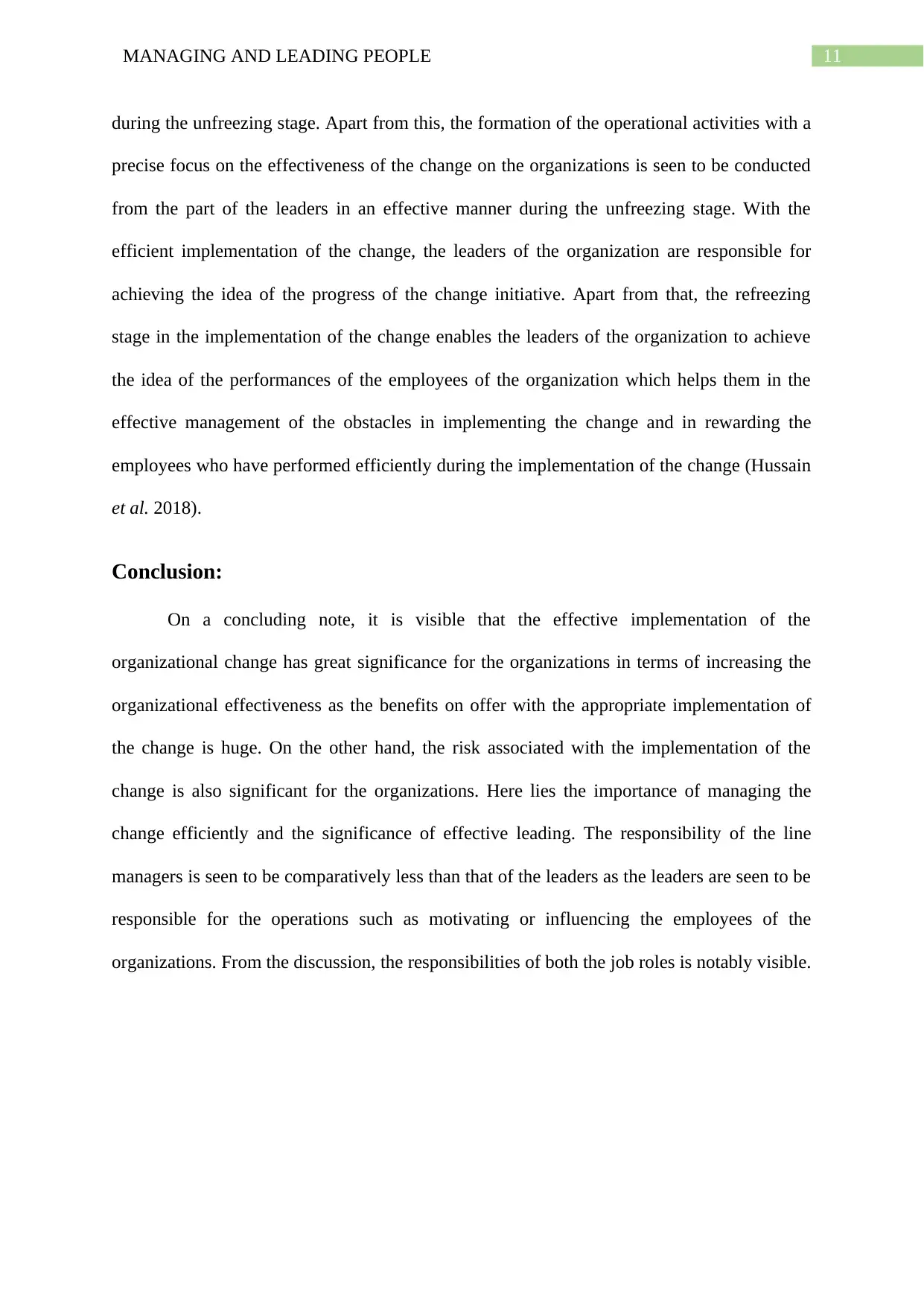
11MANAGING AND LEADING PEOPLE
during the unfreezing stage. Apart from this, the formation of the operational activities with a
precise focus on the effectiveness of the change on the organizations is seen to be conducted
from the part of the leaders in an effective manner during the unfreezing stage. With the
efficient implementation of the change, the leaders of the organization are responsible for
achieving the idea of the progress of the change initiative. Apart from that, the refreezing
stage in the implementation of the change enables the leaders of the organization to achieve
the idea of the performances of the employees of the organization which helps them in the
effective management of the obstacles in implementing the change and in rewarding the
employees who have performed efficiently during the implementation of the change (Hussain
et al. 2018).
Conclusion:
On a concluding note, it is visible that the effective implementation of the
organizational change has great significance for the organizations in terms of increasing the
organizational effectiveness as the benefits on offer with the appropriate implementation of
the change is huge. On the other hand, the risk associated with the implementation of the
change is also significant for the organizations. Here lies the importance of managing the
change efficiently and the significance of effective leading. The responsibility of the line
managers is seen to be comparatively less than that of the leaders as the leaders are seen to be
responsible for the operations such as motivating or influencing the employees of the
organizations. From the discussion, the responsibilities of both the job roles is notably visible.
during the unfreezing stage. Apart from this, the formation of the operational activities with a
precise focus on the effectiveness of the change on the organizations is seen to be conducted
from the part of the leaders in an effective manner during the unfreezing stage. With the
efficient implementation of the change, the leaders of the organization are responsible for
achieving the idea of the progress of the change initiative. Apart from that, the refreezing
stage in the implementation of the change enables the leaders of the organization to achieve
the idea of the performances of the employees of the organization which helps them in the
effective management of the obstacles in implementing the change and in rewarding the
employees who have performed efficiently during the implementation of the change (Hussain
et al. 2018).
Conclusion:
On a concluding note, it is visible that the effective implementation of the
organizational change has great significance for the organizations in terms of increasing the
organizational effectiveness as the benefits on offer with the appropriate implementation of
the change is huge. On the other hand, the risk associated with the implementation of the
change is also significant for the organizations. Here lies the importance of managing the
change efficiently and the significance of effective leading. The responsibility of the line
managers is seen to be comparatively less than that of the leaders as the leaders are seen to be
responsible for the operations such as motivating or influencing the employees of the
organizations. From the discussion, the responsibilities of both the job roles is notably visible.
⊘ This is a preview!⊘
Do you want full access?
Subscribe today to unlock all pages.

Trusted by 1+ million students worldwide
1 out of 14
Related Documents
Your All-in-One AI-Powered Toolkit for Academic Success.
+13062052269
info@desklib.com
Available 24*7 on WhatsApp / Email
![[object Object]](/_next/static/media/star-bottom.7253800d.svg)
Unlock your academic potential
Copyright © 2020–2025 A2Z Services. All Rights Reserved. Developed and managed by ZUCOL.





